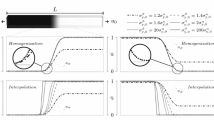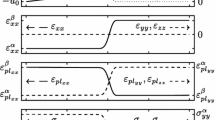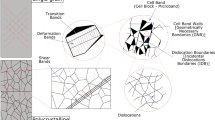Abstract
Plasticity and failure theories are still subjects of intense research. Engineering constitutive models on the macroscale which are based on micro characteristics are very much in need. This study is motivated by the observation that continuum assumptions in plasticity in which neighbour material elements are inseparable at all-time are physically impossible, since local detachments, slips and neighbour switching must operate, i.e. non-continuous deformation. Material microstructure is modelled herein by a set of point elements (particles) interacting with their neighbours. Each particle can detach from and/or attach with its neighbours during deformation. Simulations on two- dimensional configurations subjected to uniaxial compression cycle are conducted. Stochastic heterogeneity is controlled by a single “disorder” parameter. It was found that (a) macro response resembles typical elasto–plastic behaviour; (b) plastic energy is proportional to the number of detachments; (c) residual plastic strain is proportional to the number of attachments, and (d) volume is preserved, which is consistent with macro plastic deformation. Rigid body displacements of local groups of elements are also observed. Higher disorder decreases the macro elastic moduli and increases plastic energy. Evolution of anisotropic effects is obtained with no additional parameters.















Similar content being viewed by others
References
Lubliner J (1990) Plasticity theory. Collier Macmillan Publishers, New York
McDonough JM (2004) Introductory lectures on turbulence. Physics, Mathematics and Modeling. Departments of Mechanical Engineering and Mathematics, University of Kentucky
Bazant MZ (2006) The spot model for random-packing dynamics. Mech Mater 38:717–731
Ken K, Rycroft HC, Bazant MZ (2007) The stochastic flow rule: a multi-scale model for granular plasticity. Model Simul Mater Sci Eng 15:S449–S464
Kamrin K (2008) Stochastic and deterministic models for dense granular flow. Ph.D. thesis, MIT
Salman OU, Truskinovsky L (2012) On the critical nature of plastic flow: one and two dimensional models. Int J Eng Sci 59:219–254
Benichou I, Givli S (2013) Structures undergoing discrete phase transformation. J Mech Phys Solids 61:94–113
Prakash M, Cleary PW (2015) Modelling highly deformable metal extrusion using SPH. Comput Part Mech 2:19–38
Allen MP (2004) Introduction to molecular dynamics simulation, vol. 23, pp 1–28. ISBN 3-00-012641-4
Mordehai D, Lee SW, Backes B, Srolovitz DJ, Nix WD, Rabkin E (2011) Size effect in compression of single-crystal gold microparticles. Acta Mater 59:5202–5215
Horn RA, Johnson CR (1991) Topics in matrix analysis. Cambridge University Press, New York
Bathe K-J (1982) Finite element procedures in engineering analysis. Prentice-Hall, New Jersey
Shih C, Lee D (1978) Further developments in anisotropic plasticity. J Eng Mater Technol 100:294–302
Philip J (2007) The probability distribution of the distance between two random points in a box, December 2007. https://people.kth.se/~johanph/habc.pdf. Accessed 06 June 2016
Author information
Authors and Affiliations
Corresponding author
Appendices
Appendix 1
Analytical approximation for \(\langle M \rangle \) using PRS of 3 \(\times \) 3 cells
Expression for \(\langle M \rangle \) is obtained by calculating the distance distributions between two random points (particles) on a ‘perpendicular-line’ (Fig. 16a), and a ’diagonal-line’ (Fig. 16b). Then, calculating the discrete PDF for \(n = 0,1,2, \ldots ,8\) interactions and evaluating the mean.
Let two random points \((x^{1}_{1}, x^{2}_{1})\) and \((x^{1}_{2}, x^{2}_{2})\), where the \((_{\mathrm{I}})\) is the particle and \((^{\mathrm{i}})\) is the coordinate as shown in Fig. 16a. Also define r as the distance between the two points. Assuming that \(x^{1}_{1} and x^{1}_{2}\) are independent and evenly distributed in the interval \((1-\surd \lambda , 1+\surd \lambda )\) and also \(x^{2}_{1} and x^{2}_{2}\) in \((0,\surd \lambda )\), the PDF for the event \((x^{1}_{1}-x^{2}_{1})^{2}+(x^{1}_{2}-x^{2}_{2})^{2} \le r^{2}\) is the convolution \(f_{\mathrm{p}}\) of \(g_{1}\) and \(g_{2}\) [14] given by:
where \({ \beta =}\sqrt{\lambda }\). Convolving (25) with (26),
where \(T(x)=\hbox {sin}^{-1}(1-2x^{2})\) for \(0 \le x \le 1\). Notice that since q in (25) and (26) is the square of the distance, a change of variables is performed in (27) to obtain r.
The probability that a particle will interact with its neighbour located within a circle of radius R is,
which we assume is the same for all ‘perpendicular-line’ interactions appears in Fig. 3.
Next, consider two random points on diagonal-line: \((x^{1}_{1}, x^{2}_{1})\) and \((x^{1}_{2}, x^{2}_{2})\) as shown in Fig. 16b. Assuming that \(x^{1}_{1} and x^{1}_{2}\) are independent and evenly distributed in the interval \((1-\surd \lambda , 1+\surd \lambda )\) and also \(x^{2}_{1} and x^{2}_{2}\) in the same interval, the PDF for the event \((x^{1}_{1}-x^{2}_{1})^{2}+(x^{1}_{2}-x^{2}_{2})^{2} \le r^{2}\) is the convolution \(f_{d}\) of \(g_{1}\) with itself:
The probability that a particle will interact with its neighbour located within a circle of radius R is,
again, we assume \(P_{2}\) the same for all ‘diagonal-line’ interactions appears in Fig. 3.
Given the probabilities (28) and (30), we can precede to derive an expression for the discrete PDF for \(n=0,1,2,{\ldots },8\) interactions. This task is analogical to: playing two separate games (independently) where in each game the player is trying to fill 4 empty cells with 4 tries, each with different probability to fill: \(P_{1}\) and \(P_{2}\), respectively. What is the probability of having \(n = 0, 1, 2,\) etc. cells filled? Let the number of interactions from each type (‘perpendicular’ or ‘diagonal’) be \(M_{1}, M_{2}\) respectively. The \(M_{i}{} { \sim Binomial}(k = 4,P_{\mathrm{i}})\) and thus,
for \(n=0,1,2,{\ldots },8\). The mean of the discrete PDF in (31) is equal to,
Substitute Eqs. (28) and (30) into (32) and divide by 8, which is the number of interactions at \(\lambda =0\), we get (4).
Appendix 2
Analytic approximation for \(\langle E_{22} \rangle \) using a PRS of 2 \(\times \) 2 cells
Define PRS of 2 \(\times \) 2 cells where each pair of particles interacts, as shown in Fig. 17.
The structure is subjected to the following symmetry boundary conditions:
For small deformations, the displacement field of the structure u is given by the equilibrium equations:
where F is the external load vector
and K is the global stiffness matrix,
\({ \theta }_{m}\) is the angle of interaction m relative to \({{\varvec{e}}}_{1}\). From periodic geometry considerations, the stiffness of interaction k,
We classify \(\theta \) as \({ \theta }_\mathrm{p}\) and \({ \theta }_\mathrm{d}\) for ‘perpendicular-line’ and ‘diagonal-line’ of interaction, respectively. For the PRS shown in Fig. 17,
\({ \theta }_\mathrm{p}\) and \({ \theta }_\mathrm{d}\) have distinctive PDF which depends on \(\lambda \) and can be found analytically, similar to the method used in Appendix 1. Substituting (38) into (36) yields a stochastic stiffness matrix:
Substituting Eqs. (39) and (35) into (34), we derive an expression for the stochastic displacement field u. More specifically, the structure’s average displacement in e \(_{2}\),
where \(S_{ij}\) are entries from the compliance matrix S.
The initial stochastic stiffness \(E_{22}\) is the total force f divided by (40):
Dividing (41) by \({E}_{0}=3k_{0}/2\) and calculating the inverse of (39) we derive Eq. (22).
Rights and permissions
About this article
Cite this article
Ben-Shmuel, Y., Altus, E. Modeling plasticity by non-continuous deformation. Comp. Part. Mech. 4, 487–501 (2017). https://doi.org/10.1007/s40571-016-0142-3
Received:
Revised:
Accepted:
Published:
Issue Date:
DOI: https://doi.org/10.1007/s40571-016-0142-3






